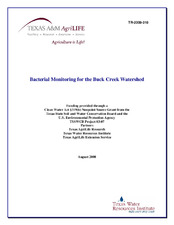| dc.description.abstract | The “Bacterial Monitoring for the Buck Creek Watershed” project was developed in response to the creek’s listing on the Texas Water Quality Inventory and 303(d) List due to a bacterial impairment and subsequent total maximum daily load (TMDL) development. Due to limited data, local soil and water conservation districts (SWCD) led the effort to have this TMDL process suspended to allow for further data collection and analysis. The Texas State Soil and Water Conservation Board (TSSWCB) was contacted to seek their assistance in developing and funding a project that would substantially increase the amount of monitoring conducted on the creek.
The Texas Water Resources Institute (TWRI) was contracted to develop the project and to coordinate the needed personnel to conduct this study. With the help and cooperation of the Texas AgriLife Research and Extension Center at Vernon, a work plan was developed to collect water samples and conduct water quality monitoring every other week at 13 different sites along the creek. The proposed work plan was then submitted to TSSWCB for funding through the U.S. Environmental Protection Agency’s (EPA) 319 (h) program which focuses on funding activities that address nonpoint source (NPS) pollution. The proposal was approved by EPA and project activities began in October 2003.
Sampling began in May 2004 and continued through May 2007 yielding a total of 78 sampling trips. During these trips, a 100 mL water sample was collected and returned to the laboratory for E. coli analysis. Additional water quality parameters including dissolved oxygen (DO), potential hydrogen (pH), salinity, specific conductance, temperature, and water depth were taken. Other information about the current conditions was recorded on field data sheets and included air temperature, when the most recent rain event was, flow and weather conditions. Water samples and their corresponding water quality data were not collected during all sampling trips due to impassable roads, no water present at the site, standing water or flow too low to collect a sample or adverse weather conditions.
Data review showed that Buck Creek exhibited elevated bacteria levels at several locations and in some cases, enough to exceed the state’s bacteria standards. State water quality standards dictate that the geometric mean of at least 10 samples collected within a 5-yr time frame must be < 126 colony forming units (cfu) / 100 mL of water and no more than 25 percent of the individual samples collected can exceed 394 cfu / 100 mL. Several individual sites did not meet these criteria and several others were close to exceeding those limits.
Results from this study indicate that elevated E. coli levels periodically exist in Buck Creek. Implementing proper management measures in the watershed will aid in decreasing the impacts of E. coli on the creek. Additional information about the sources of bacteria in Buck Creek is needed before sound management measures can be recommended, developed and implemented into a feasible plan of action. A project to collect the needed information and to develop a watershed protection plan (WPP) for Buck Creek has been funded and initiated. Stakeholder support and involvement have grown over the course of the bacterial monitoring project and the continued support and participation of those involved will be vital to successfully improving the creek’s water quality. | en |


